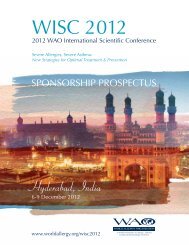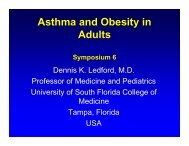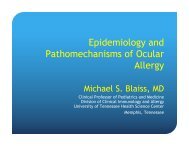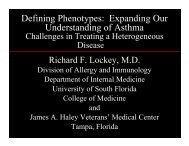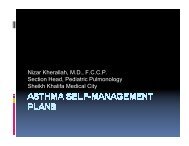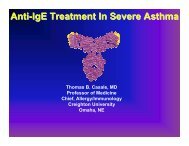Dubai Final-v20.indd - World Allergy Organization
Dubai Final-v20.indd - World Allergy Organization
Dubai Final-v20.indd - World Allergy Organization
Create successful ePaper yourself
Turn your PDF publications into a flip-book with our unique Google optimized e-Paper software.
ABstrACts<br />
ABstrACts<br />
(30.3%), 4 (20%) e 40 (32%); in 89 F, 14 ms e 75 Ps, respectively 53 (67.6%), 44 ( 80%) and 9 (65.6%), with ri 35 (39.3%), 4<br />
(38.6%) and 31 (41.3%): globally a little higher prevalence of m (ri+As), and of F ri particularly if ms. similar findings were found<br />
relating (ri+As) to ss or Pr slit if ms and Ps. Conclusions<br />
slit selection seems independent from sex, pathology and kind of sensitivity and is suitable for all seasonal antigens.<br />
3206<br />
a SUrVEY oF allErgEn SPECiFiC immUnoTHEraPY in KorEa<br />
Hur, g. 1 , Kim, t. 2 , Han, m. Y. 3 , nahm, D. 4 and Park, J. 5<br />
1 2 internal medicine, Korea University College of medicine, seoul, south Korea. Department of <strong>Allergy</strong> and Clinical immunology,<br />
Asan medical Center, University of Ulsan College of medicine, seoul, south Korea. 3Pediatrics, Pochon CHA University College of<br />
medicine, seoul, south Korea. 4<strong>Allergy</strong> & rheumatology, Ajou University school of medicine, seoul, south Korea. 5Division of <strong>Allergy</strong><br />
& immunology Department of internal medicine, Yonsei University College of medicine, seoul, south Korea.<br />
Background; Allergen-specific immunotherapy (sit) has been used as the only curative and specific treatment for allergic<br />
diseases. there have been no data on sit in Korea. therefore, we carried out a survey to observe the prescription pattern of allergy<br />
specialists in Korea.<br />
methods; All 690 members of the Korean Academy of Asthma, <strong>Allergy</strong>, and Clinical immunology received an e-mail attaching a<br />
questionnaire on sit, and were required to return the answers. All returned answers were recruited between August 2009 and<br />
september 2009.<br />
results; the response rate was 21.0%. Among them, 42.8% was physicians, 32.4% was pediatricians, and 20.7% was<br />
otolaryngologists. Only 69% of respondents performed sit in practice. the methods used to detect causative allergens were skin<br />
prick test (46.1%) and serologic tests (44.1%) such as immunoCAP and mAst. the limitations to to start sit in their own practice<br />
were lack of equipment (21%) and practical experience (15.8%), no necessary because pharmacotherapy alone was enough to<br />
treat (14.5%), no good profit (14.5%), and its risks for adverse reactions (13.2%). the target diseases for sit were allergic rhinoconjunctivitis<br />
(46%), allergic asthma (38%), and atopic dermatitis (10%). ninety-two allergic specialists (82%) performed sit via<br />
subcutaneous route (sCit) and 18% via sublingual route (slit). the allergens used for sCit were house dust mites (42.5%), pollens<br />
(31.3%), and animal dander (10.2%). twenty-eight (30%) doctors have experienced anaphylactic reaction during sCit. About 40%<br />
of doctors have experienced any adverse reaction including local reactions during slit.<br />
Conclusion; in Korea, 69% of allergy specialists performed sit in practice. the prevalence of sCit was 82% and slit was 18%.<br />
lack of equipment and practical education were critical barrier to performing sit in doctors. therefore, proper practical educations<br />
to update information on sit will be necessary for allergy specialists.<br />
3207<br />
SUCCESSFUl gamma-inTErFEron THEraPY in a CaSE oF rEFraCTorY VaCCinE-aSSoCiaTED aBSCESS in a CgD<br />
PaTiEnT<br />
nabavi, m. 1 , maherbanai, s. 1 and Bemanian, m. H. 2<br />
1 2 semnan medical University, tehran, iran. Yazd medical university, Yazd, iran.<br />
CgD is a rare phagocyte defect with an incidence of four to five per million individuals, caused by genes affecting one X-linked and<br />
three autosomal recessive chromosomes. it is associated with recurrent abscesses of different size and locations. We present an 8<br />
year old girl who developed large abscesses at her thigh since 2 years of age.<br />
Case report:<br />
the patient is an 8 year old girl who developed a large abscess at her thigh just at the site of childhood vaccinations when she was<br />
2 years of age. the large 4×5-sized abscess contained voluminous yellow-greenish pus which led to persistent drainage. many<br />
topical and systemic antibiotics were used without any result and multiple courses of hospitalizations with intravenous use<br />
of wide-spread antibiotics had no benefits. gram stain and smear always showed a mixture of microbial agents for instance<br />
staphylococcus, either s. alba or s.aureus. the abscess had 2 to 4 stoma apart from each other and sometimes locolation of pus<br />
posed the need to incision and drainage of mutiple sites. Once acid fast bacilli were grown and anti tubercolosis medications<br />
were prescribed and used for at least 9 months without any significant relief. Because of refractoriness of abscesses , phagocyte<br />
defect were sugessted and an immunological consultation performed when she was 6 years of age. immunoglobulines were within<br />
normal limits. nitro Blue tetrazolium (nBt) and Di Hydro rhodamine test (DHr) was performed and showed a significant defect<br />
of respiratory burst and the patient regarded as “ Chronic granulomatous Disease”. long term therapeutic doses of trimetoprimsulfisoxazole<br />
followed by continous prophylaxis, resulted to some relief. introduction of gamma- interferon as an every-other-day<br />
schedule were terminally led to closure of abscess stoma and terminated the discharge. multiple scars of previously draining<br />
www.worldallergy.org 148<br />
FinAl PrOgrAm



